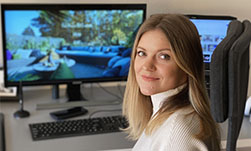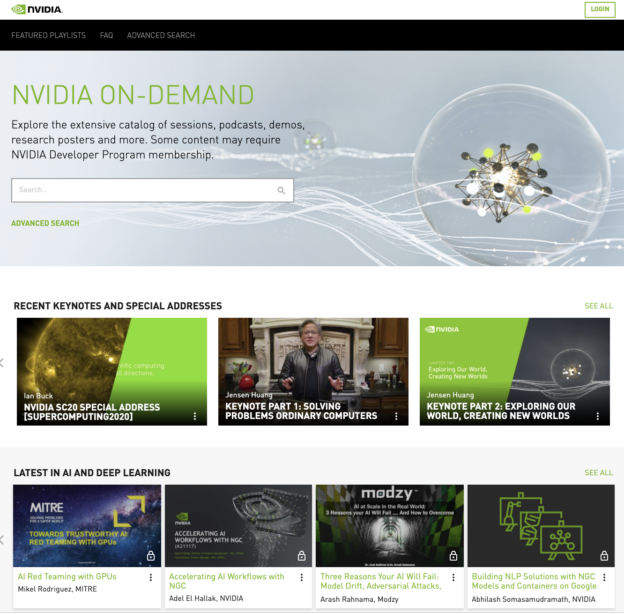 This article covers an interview with OIa Stalmach, co-creator of House or Crickets, a 2020 DXR Spotlight Contest Winner.
This article covers an interview with OIa Stalmach, co-creator of House or Crickets, a 2020 DXR Spotlight Contest Winner.
An interview with OIa Stalmach, co-creator of House or Crickets, a 2020 DXR Spotlight Contest Winner
During the cold of winter, you may find the video for House of Crickets (below) comforting. Ola Stalmach and Jakub Lesniak have used real-time ray tracing techniques to create a warm, inviting summertime space that looks real enough to get you checking how much a rental might cost.
NVIDIA: What is the development team size for House of Crickets?
Ola: It’s pretty small, only me and my partner (Jakub Lesniak). I’m working mostly on the artistic side of projects like interior design, creating moods and environments. Kuba helps me to improve the technical side of it and make the Unreal magic work in a hundred percent.
NVIDIA: Your demonstration looked so real, I wanted to move into that space! Is the visualization based on a real location?
Ola: I am so happy that you like it. Yes, the visualization is based on a real location. This is actually a project of my small apartment settled in attached houses near Krakow in Poland. The whole point was to make something beautiful in a normal, very standard house with a tiny garden.
NVIDIA: What real-time ray tracing features did you build into House of Crickets, and why?
Ola: I’ve used all available features (the less visible is Raytraced Ambient Occlusion). Since the iteration of ray tracing in Unreal Engine 4.25 it finally started working for me, especially Raytraced Indirect Illumination.
This technology is the future of graphics, so it is good to start getting to know it if you plan to visualize amazing worlds in the future. What I really love to see in architecture visualisations are great accurate reflections and shadows, which were really hard to achieve for me with previous real-time technology.
NVIDIA: A lot of developers starting out with DXR struggle with performance because they try to make everything reflective. Do you have any advice on materials to use when building an environment that will be ray traced?
Ola: There is that balance between roughness, noise reduction algorithm and number of reflection samples. I would try to avoid middle-reflective surfaces, high values of reflection samples and bounces. It is all about tweaking and playing with materials and sacrificing something in the way.
NVIDIA: How long did it take to develop this demo?
Ola: I think I spent a total 1 month, maybe more just learning what is possible. It was done in my free time for my small Studio OS.
NVIDIA: What’s next for you with real-time ray tracing?
Ola: I already use ray tracing (or the hybrid with lightbaking) in at least 80% of my projects. The plans are not only for architecture designs, but also to use it in Virtual Production, which I’ve gotten deeply into in the past two years. I’m looking forward to new improvements in both Engine and Hardware. Ray tracing will allow me to focus only on the artistic side of my creations and work with just intuition taken from the real World.
To learn more about Ola’s work, you can check out her social handles: Twitter, Facebook, Artstation, and Instagram pages.
Learn about NVIDIA’s tools for Game Developers here.

 Determined AI’s application available in the NVIDIA NGC catalog, a GPU-optimized hub for AI applications, provides an open-source platform that enables deep learning engineers to focus on building models and not managing infrastructure.
Determined AI’s application available in the NVIDIA NGC catalog, a GPU-optimized hub for AI applications, provides an open-source platform that enables deep learning engineers to focus on building models and not managing infrastructure.  The CMake package and build system for both libraries continue to improve with add_subdirectory support, installation rules, status messages, and other features that make these libraries easier to use from CMake projects.
The CMake package and build system for both libraries continue to improve with add_subdirectory support, installation rules, status messages, and other features that make these libraries easier to use from CMake projects.  Data augmentation technique enables AI model to emulate artwork from a small dataset from the Metropolitan Museum of Art — and opens up new potential applications in fields like healthcare.
Data augmentation technique enables AI model to emulate artwork from a small dataset from the Metropolitan Museum of Art — and opens up new potential applications in fields like healthcare. Researchers, developers, and engineers from all over the world are gathering virtually this year for the 2020 Neural Information Processing Systems (NeurlPS). NVIDIA Research will present its research through spotlight and posters.
Researchers, developers, and engineers from all over the world are gathering virtually this year for the 2020 Neural Information Processing Systems (NeurlPS). NVIDIA Research will present its research through spotlight and posters. Watch part 1 of our popular NVIDIA On-Demand session, Rendering Game With Millions of Ray Traced Lights, where NVIDIA’s Chris Wyman provides an overview on reservoir spatiotemporal importance resampling (ReSTIR).
Watch part 1 of our popular NVIDIA On-Demand session, Rendering Game With Millions of Ray Traced Lights, where NVIDIA’s Chris Wyman provides an overview on reservoir spatiotemporal importance resampling (ReSTIR). Now available to all NVIDIA Developers, NVIDIA On-Demand is a catalog of technical sessions, podcasts, past keynotes, demos, research posters and more from NVIDIA GPU Technology Conferences across the global, as well as leading industry events.
Now available to all NVIDIA Developers, NVIDIA On-Demand is a catalog of technical sessions, podcasts, past keynotes, demos, research posters and more from NVIDIA GPU Technology Conferences across the global, as well as leading industry events.
 To help AI research like this make the leap from academia to commercial or government deployment, NVIDIA recently announced the Applied Research Accelerator Program. The program supports applied research on NVIDIA platforms for GPU-accelerated application deployments.
To help AI research like this make the leap from academia to commercial or government deployment, NVIDIA recently announced the Applied Research Accelerator Program. The program supports applied research on NVIDIA platforms for GPU-accelerated application deployments. Announcing a preview release of Isaac Gym – NVIDIA’s physics simulation environment for reinforcement learning research.
Announcing a preview release of Isaac Gym – NVIDIA’s physics simulation environment for reinforcement learning research.